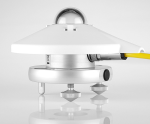
Doppelte Glaskuppel






Überblick
Der CMP11 ist ein ISO Secondary Standard Pyranometer, das die Solarstrahlung über das gesamte Spektrum misst. Er wird direkt an einem Campbell-Datenlogger angeschlossen und ist geeignet für meteorologische Netzwerke und Forschung und Entwicklung für die Solarenergiegewinnung.
In Stationen zur Solarforschung wird auch oft der CMP10 eingesetzt.
Lesen Sie mehrFunktionen und Vorteile
- Detektor Design und schnellere Antwort als der CMP6
- Kompatibel mit fast allen Campbell Scientific Datenloggern
- Integrierte Libelle ist sichtbar ohne dass man den Sonnenschutz abnehmen muss
- Kartusche mit Trockenmittel verhindert die Ansammlung von Tau auf der Innenseite der Kuppel
- Kompatibel mit dem CVF4 Heizung/Ventilator , der die Kuppeln frei von Eis und Feuchtigkeit hält
- Misst reflektierte Solarstrahlung von umgekehrt angebracht
- Misst in direktem Sonnenlicht, unter Pflanzendecken, bei wolkigem Himmel und bei künstlichem Licht
- Kompatibel mit dem CWS900 Interface
Bilder








Zugehörige Produkte
Technische Beschreibung
The CMP11 measures solar radiation with a high-quality blackened thermopile protected by two glass domes. Its flat spectral sensitivity, from 285 to 2800 nm, makes it ideal for applications in natural sunlight, under plant canopies, in green houses or buildings, and inverted to measure reflected solar radiation.
A desiccant-filled drying cartridge prevents dew from forming on the inner sides of the CMP11's domes. Campbell Scientific also offers the CVF4 heater/ventilator that keeps its domes free from ice and dew.
The CMP11 includes a white snap-on sun shield that reduces the sensor's temperature. A bubble level and adjusting leveling screws enable the sensor to be leveled without using a leveling base.
The CMP11 produces a millivolt signal that is measured directly by a Campbell Scientific datalogger.
Kompatibel mit
Please note: The following shows notable compatibility information. It is not a comprehensive list of all compatible products.
Datenlogger
| Product | Compatible | Note |
|---|---|---|
| CR1000 (retired) | ||
| CR1000X (retired) | ||
| CR200X (retired) | ||
| CR216X (retired) | ||
| CR300 (retired) | ||
| CR3000 | ||
| CR310 | ||
| CR350 | ||
| CR5000 (retired) | ||
| CR6 | ||
| CR800 (retired) | ||
| CR850 (retired) | ||
| CR9000X (retired) |
Additional Compatibility Information
Mounting
The CMP11 has a bubble level and two leveling feet, which allow it to be leveled without using a leveling base. This pyranometer mounts to a mast, crossarm, or pole (1.0 in. to 2.1 in. OD) via the CM255 or CM255LS mounting stand. The CMP11 should be mounted away from all obstructions and reflective surfaces that might adversely affect the measurement.
Spezifikationen
| ISO Classification | Class A (secondary standard) |
| Spectral Range | 285 to 2800 nm |
| Sensitivity | 7 to 14 µV/W/m2 |
| Temperature Dependence of Sensitivity | < 1% (-10° to +40°C) |
| Response Time | < 5 s (95% of final value) |
| Zero Offset Due to Thermal Radiation | < 7 W/m2 (200 W/m2) |
| Non-Stability | < 0.5% (change/year) |
| Non-Linearity | < 0.2% (0 to 1000 W/m2) |
| Directional Error | < 10 W/m2 (up to 80° with 1000 W/m2 beam) |
| Tilt Error | < 0.2% |
| Level Accuracy | 0.1° |
| Impedance | 10 to 100 Ω |
| Operating Temperature Range | -40° to +80°C |
| Typical Signal Output | 0 to 15 mV (for atmospheric applications) |
| Maximum Irradiance | 4000 W/m2 |
| Expected Daily Uncertainty | < 2% |
| Dome Diameter | 5 cm (2 in.) |
| Width | 15 cm (5.9 in.) with shield |
| Height | 9.25 cm (3.64 in.) |
| Weight | 0.9 kg (2 lb) with 10.1 m (33 ft) cable |
FAQs für
Number of FAQs related to CMP11: 5
Alle anzeigenWenige anzeigen
-
No. These are all passive devices that create their own voltage signal as a response to the measurement being made. There is, however, a heater and ventilator for these sensors (CVF4-L) that requires a power supply.
-
Because of the loss of IR radiation, nearly all thermopile instruments typically have a negative offset. This offset is most easily visible at night-time, when a small negative value is read instead of zero. This same offset is present during the daytime, but it is not as visible because of the large solar signal.
Another common issue involves leveling an instrument. Leveling a thermopile instrument can cause errors in the direct beam component because the cosine response is not correct. These errors are more notable when the sun is close to the horizon because the angle is so shallow.
-
The ISO and WMO classify First Class pyranometers, such as the CMP6-L, as suitable for network operations. However, if accuracy is of paramount concern, consider using Secondary Standard pyranometers, such as the CMP11-L and CMP21-L, instead.
-
All of these pyranometers measure the amount of solar short-wave radiation incident on a surface. Because of their accuracy and performance level, the CMP11-L and CMP21-L are classified by the International Organization for Standardization (ISO) and World Meteorological Organization (WMO) as Secondary Standard sensors, representing the highest level of measurements made by pyranometers. In comparison, the CMP6-L is classified as a First Class sensor, which is the middle classification for pyranometers. (Second Class is the lowest pyranometer classification.)
-
To incorporate a sensor that is compatible with wireless sensor interfaces into a wireless network, a CWS900-series wireless sensor interface is needed, as well as an A205 CWS-to-PC interface to configure it.
Anwendungsbeispiele
Historically, the South African energy sector had been monopolized by a single state-owned utility company......lesen Sie mehr


